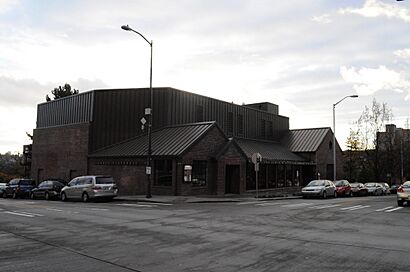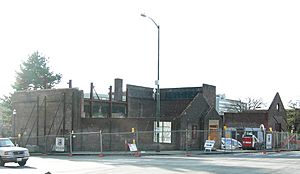Playhouse Theatre (Seattle) facts for kids
 |
|
| Located at | Seattle |
|---|---|
| Coordinates | 47°39′24″N 122°18′50″W / 47.6566°N 122.314°W |
| Country | United States |
The Playhouse Theatre is a historic theater in Seattle, Washington. It is located in the University District at 4045 University Way NE. This building was once a tile warehouse. In 1930, Burton and Florence James turned it into a theater. They started the Seattle Repertory Playhouse there. This theater was special because it had performers and audiences from many different backgrounds.
During the New Deal era, the theater received money from the Federal Theatre Project (FTP). This funding helped them create the Negro Repertory Company. This was one of four FTP groups in Seattle. The University of Washington bought the building in 1950. They used it for their theater department. In 1967, the stage was changed from a proscenium (a traditional stage with an arch) to a thrust stage (a stage that sticks out into the audience). The building was updated and improved between 2007 and 2009.
Contents
History of the Playhouse Theatre
The James Family and Early Theater
Burton James (1888–1951) and Florence James (1892–1988) were a couple from New York. They moved to Seattle in 1923. They helped start the theater department at the Cornish School. In 1928, they left Cornish College. This happened after the school disagreed with their play Six Characters in Search of an Author.
The Jameses then started their own group called the Seattle Repertory Playhouse. This group was known for being brave and including people of all races. They performed many different types of plays. These ranged from funny comedies to serious works by famous writers like Ibsen. In 1930, they opened their own theater. It was built in an old tile warehouse. The Jameses also taught some classes at the University of Washington.
Federal Theatre Project and the Negro Repertory Company
In 1933, their play In Abraham's Bosom was a big hit. It featured many Black actors and a gospel choir. This play was made with Seattle's First African Methodist Episcopal Church. When the Federal Theatre Project began in 1935, the Jameses applied for funding. They wanted to start a theater group with Black actors. This group would be based at their theater.
Their idea was approved. The Negro Repertory Company started in January 1936. It worked with the Seattle Urban League. The national director of the Federal Theatre Project, Hallie Flanagan, thought this was the best "Negro unit" in the program. Historians say they put on some of the most experimental shows. Many African Americans in Seattle were involved in these plays.
The company performed plays like Stevedore. This play was about a Black worker who was falsely accused of a serious crime. His union fought for him. There is a story that the Black actors changed the ending of the play. They showed the Black workers fighting an angry crowd by themselves. In 1937, a play called Lysistrata was stopped after one night. This happened because some people complained about its content. The Negro Repertory Company was performing it at the larger Moore Theatre. The actors also decided not to perform Porgy and Bess. They felt the material was not respectful.
Important playwrights from this group included Theodore Browne. He wrote The Natural Man. Joe Staton also helped a lot. He adapted the work of Paul Laurence Dunbar for a popular show. The Jameses left in 1937 after a public disagreement about their play Power. However, they kept running their theater. The Negro Repertory Company continued as long as it had funding.
Challenges and Sale to the University
In 1939, the U.S. Congress ended the Federal Theatre Project. This was due to concerns about some of its plays and political ideas. After World War II, the Jameses continued to support workers' rights. They also let groups like the Group Health Cooperative use their theater.
In 1948, the Jameses had to speak before the Washington State Legislature's Canwell Committee. This committee was looking into certain political ideas at the University of Washington. The Jameses lost many of their supporters. By 1950, their theater was having money problems. They sold it to the university. Burton James became ill around this time. Florence James continued her theater work in Saskatchewan, Canada.
The University's Era of the Playhouse
The university renamed the building the University of Washington Playhouse Theatre. They used it regularly for their growing drama department. In 1967, Greg Falls changed the stage. He converted it from a traditional proscenium stage to a thrust stage. This new stage design allowed actors to be closer to the audience.
From 2007 to 2009, the university did a big renovation of the building. They worked with LMN Architects. They added an extra story to the roof. They also made the seating better and improved the lighting. The building was also made stronger to withstand earthquakes. The building was renamed the Floyd and Delores Jones Playhouse. This was to honor a foundation that gave US$2.4 million for the project. Floyd Jones wanted the name to honor his late wife. She loved the arts and social justice.
See also
- Albert M. Ottenheimer


